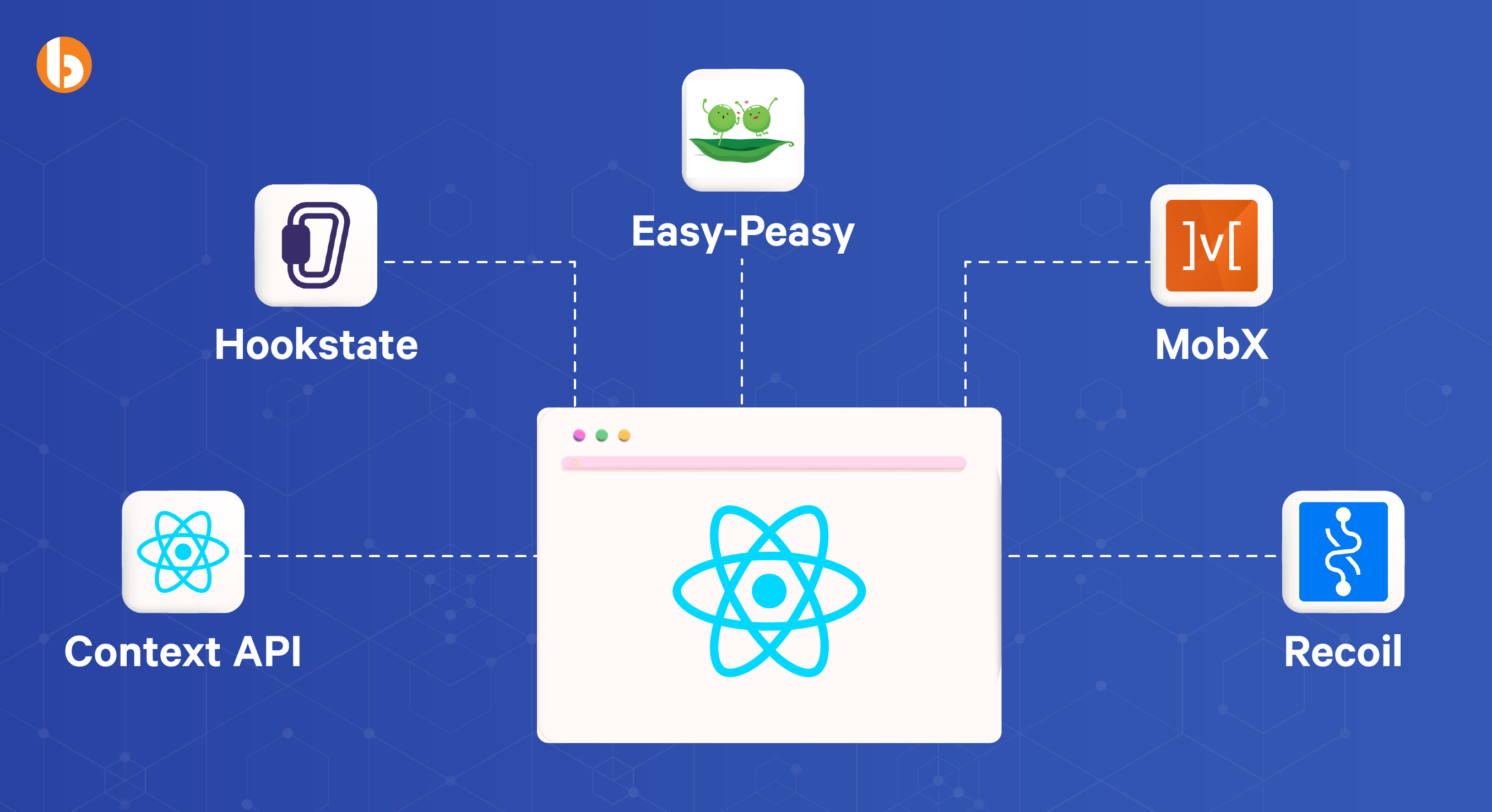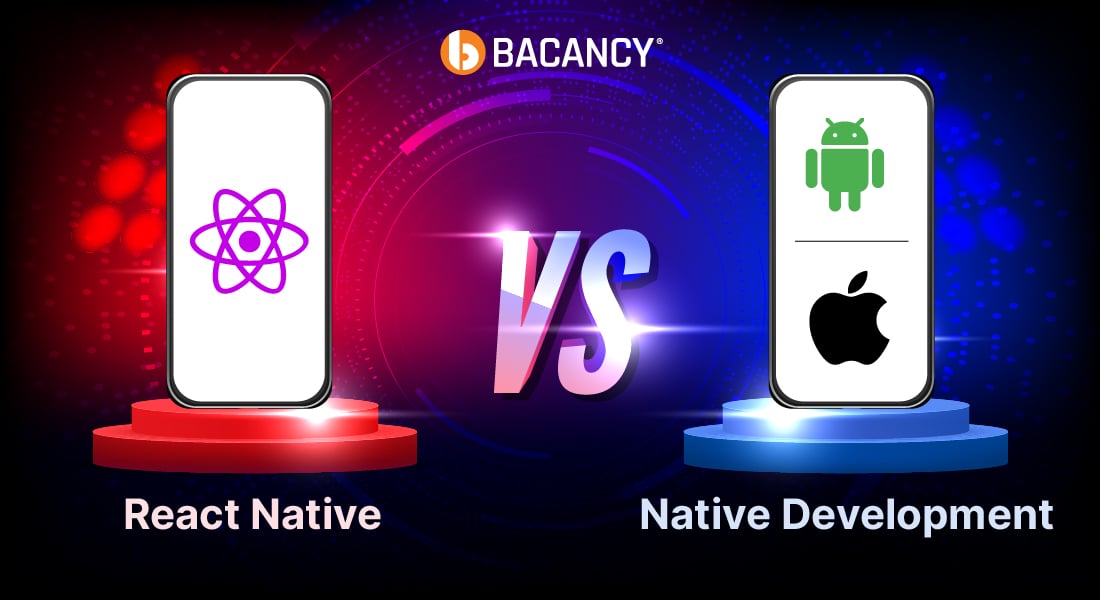Quick Summary:
When creating complex applications in React Native, managing states and dealing with multiple users and screens will be difficult using the built-in features. However, State Management in React Native helps to develop robust and powerful applications by ensuring smooth flow and data sharing across all components. As a business owner or entrepreneur, you should know how React Native state management makes it easy for developers to build enterprise applications for your business. In this blog post, we will explore more about State Management, its use in React Native, various libraries, examples, and more.
Table of Contents
React Native State Management: Overview
When you are working with multiple components based on different origins but sharing the same state during the application development, it will be difficult to pass the props down to each component. That’s where state management hops in, offering an effective way to share and manage this data across the application components.
The state is a fancy term used to describe the summarized data where you can store the assets and change them as per requirements. Managing a React Native application state is a problematic concept for newbies learning React Native. But the extensive state management tools make it easy for frontend developers to simplify communication and data sharing across the system. Changing the state by interacting with the application can completely change the UI experience.
State management in React Native can be preferable when developing enterprise-level mobile or web applications. It is a crucial aspect to consider when aiming for a coherent user experience without risking the loss of data due to ineffective communication. There are plenty of React Native state management libraries available on the npm registry including redux, recoil, hooks, and more. Each one is designed to serve its purpose and has its own perks to endure. Thus, choosing the best state management library depends on your project requirements and goals to achieve.
How State Management in React Native is Beneficial?
Being one of the challenging aspects of building complex applications, State management refers to the data that defines the overall behavior and functionality of the application. The mobile or web applications built using React Native have built-in mechanisms for managing the state, allowing components to store the data and update the state internally. The built-in state management works well with simple applications that have very few functions. However, as the complexity of the application grows, managing states shared between the components becomes difficult.
With the use of various state management tools, developing complex applications with multiple screens and users becomes feasible. Not only choosing the best state management for React Native helps simplify the process and prevent inconsistencies due to scattered processes, but it also improves the overall user experience of the application. Now, let’s explore some other reasons why you should use React Native state management.

Avoid repetitive data sharing
State management tools allow you to reuse the existing functions, making easy data sharing across the application. It will be possible for developers to retrieve the state of the application component without using complex prop drilling, a situation where the same data is sent to the other component via interconnected components. When you want to share the data with multiple nested components, props drilling is considerable. But it can lead to more complexity of the code and data structure.
Maintain a single data source
There will be several instances during application development coding where programmers will have to access the data of the variables located at numerous places. However, using state management tools will allow them to get the data from a single data source. It will not be essential to access data from multiple sources to obtain the state of the app which is indeed time consuming.
Scalable data across multiple components
When developing React Native web applications for large businesses, developers have to consider scalability as a crucial factor. With respect to building scalable applications, state management tools and libraries are helpful in avoiding bugs and errors in the long run. It will improve the quality of the code and make it easily manageable during the app development process.
React Native State Management Libraries
The state management libraries in React Native can be handy when you are working on scalable and complex applications. Managing states will require advanced libraries for smooth and efficient data sharing and communication between the components without passing down the props. The state management library can be useful for apps with complicated workflows, where you need to access different parts of the code to execute or develop a single functionality.
Although there are countless React Native state management libraries available, some of the most popular ones are as follows:

Context API
Context API allows developers to share the data through the component tree without using entry-level manual props drilling. With the use of context API, developers can get cleaner code along with easy sharing of the states internally in the application. It is specifically designed in a way to share the global data through a React component tree, such as the current authenticated user, theme, or preferred language. Context API is favorable when accessing data from various components at multiple nesting levels.
Why To Use:
- Effectively produce global variables
- Manage states without props drilling
- An easier and lighter approach
- Easy data sharing from a parent to deeply nested children
- State management for enterprise applications
Ready to take your React Native app’s state management to the next level?
Hire React Native developer now and experience faster, more efficient, and more scalable state management solutions!
Easy-Peasy
As the name suggests, this React Native state management tool makes managing states easy-peasy. With Easy-Peasy, you can get the benefit of minimal coding and boilerplate, offering simple and flawless state management as compared to other third-party libraries. Being a combination of multiple state management methods, Easy-Peasy provides extensive support for APIs based on React Hooks and Redux Middleware as well. This state management library utilizes Redux to manage states internally, allowing developers to enhance the application store.
Why To Use:
- Removes Redux abstractions
- Simplified state management process
- Provides an intuitive API to quickly manage states
- Offers support for API based on React Hooks and Redux Middleware
- Simple and easy-to-understand coding
Mobx
The simple and minimal boilerplate code of Mobx makes the state management easy in React Native. Changing the code will not be necessary as it is more similar to JavaScript. Additionally, you will not have to use a new architecture like you have to with Redux. It is designed specifically to simplify managing the state across the entire application through its varied components. Another advantage of using Mobx is its mutability feature that silently updates the state when you don’t want any side effects.
Why To Use:
- Helps objects emit new changes to which the observer reacts
- Effortless and scalable state management
- Transparently Applying Functional Reactive Programming (TFRP)
- A battle-tested library with the freedom to scale
- Simplified writing, testing, and debugging of the code
Recoil
Recoil is well known among developers as it is a boilerplate-free API. Due to its straightforward interface, similar to React local state, it will be easy to manage and share states during the application development. In comparison to Redux and Context API, developers can conveniently discard useless re-renders in Recoil. When using Recoil for state management, any React component can access the atoms storing the state. You can experience a uniform method to share the state when resolving app performance issues.
Why To Use:
- Simple and compatible state management approach
- Developed specifically for React components
- Super easy to integrate with React Native
- A good choice when developing small applications
- Allows to initialize storage with a selector and a dispatchable action
React Native State Management Examples
When you seek the best React Native state management tools, understanding the behavior and functionality of each one is essential. As React Native is favorable for building cross-platform app development, developers have to ensure managing the state effectively. To help you get a better idea, here are a few examples of how you can use different libraries or tools for state management in React Native.
Local State Management

import React, { useState } from 'react';
import { View, Text, Button } from 'react-native';
const Counter = () => {
const [count, setCount] = useState(0);
const incrementCount = () => {
setCount(count + 1);
};
return (
< View >
< Text >Count: {count}
< Button title="Increment" onPress= {incrementCount} / >
);
};
export default Counter;
When using the local state management in React Native, you need to use the useState() hook which is used to manage the state in the functional component.
We have used const [count, setCounter] = useState(0); in the above example. Here, useState() returns a pair of values to a current state and a function which updates the current state.
You should understand that the count is a current state variable and setCount is a function which is used to update the value of count. So, when a user clicks on the Increment button, the script will call the incrementCount function, resulting in incrementing the count state by 1. Ultimately, the updated count state value will be rendered on the screen.
Context API

import React, { createContext, useContext, useState } from 'react';
import { View, Text, Button } from 'react-native';
const CountContext = createContext();
const CounterProvider = ({ children }) => {
const [count, setCount] = useState(0);
const incrementCount = () => {
setCount(count + 1);
};
return (
< CountContext.Provider value= {{ count, incrementCount }} >
{children}
);
};
const Counter = () => {
const { count, incrementCount } = useContext(CountContext);
return (
< View >
< Text>Count: {count}< / Text>
< Button title="Increment" onPress={incrementCount} / >
);
};
export { CounterProvider, Counter };
Although Context API is not a standalone library, it is a viable option as per the functional requirements. To hold the data or value in the state and the incrementCount function, you can use the createContext and useContext hooks to create a CountContext object. Then, you will have to wrap the Counter component using CounterProvider and integrate it with the CountContext object. In order to access the count state and the incrementCount function, the Counter component uses the useContext hook. The accessed state value will be rendered on the screen.
Redux

import React from 'react';
import { View, Text, Button } from 'react-native';
import { createStore } from 'redux';
import { Provider, useSelector, useDispatch } from 'react-redux';
const initialState = {
count: 0,
};
const incrementCount = () => {
return {
type: 'INCREMENT_COUNT',
};
};
const reducer = (state = initialState, action) => {
switch (action.type) {
case 'INCREMENT_COUNT':
return {
...state,
count: state.count + 1,
};
default:
return state;
}
};
const store = createStore(reducer);
const Counter = () => {
const count = useSelector((state) => state.count);
const dispatch = useDispatch();
return (
< View >
< Text >Count: {count}< / Text>
< Button title="Increment" onPress={() => dispatch(incrementCount())} / >
);
};
const App = () => {
return (
);
};
export default App;
Another state management library you can use is Redux. You will have to define the initial state object, a reducer function, and a store object. Defining the reducer function will update the state according to the dispatched actions, and a store object will hold the state and reducer.
Thereafter, you can use the useSelector hook to pick the count state from the store and the useDispatch hook to dispatch the incrementCount action when the user clicks on the Increment button. Similar to Context API, you will have to wrap the Counter component using a Provider component and integrate it with the Redux store object.
Unlock the full potential of your React Native app with our state management expertise.
Our team of experienced developers will work with you every step of the way to create a high-quality, user-friendly, and scalable app. Contact us today to start building your dream app! We are the ideal React Native app development company to achieve your business goals.
Mobx

import React from 'react';
import { View, Text, Button } from 'react-native';
import { observable, action } from 'mobx';
import { observer } from 'mobx-react';
class CounterStore {
@observable count = 0;
@action incrementCount() {
this.count++;
}
}
const counterStore = new CounterStore();
const Counter = observer(() => {
return (
< View >
Count: {counterStore.count}< / Text>
< Button
title="Increment"
onPress={() => counterStore.incrementCount()}
/ >
);
});
export default Counter;
Using Mobx for state management, you need to create a CounterStore class with an observable count property and an incrementCount action in order to update the count property. Additionally, you will also have to create a counterStore object using the CounterStore class. Then, you need to wrap the Counter component using the observer function from the mobx-react library. The Counter component should be reactive to changes in the counterStore object. Hence, whenever the user presses the Increment button, the script will call the incrementCount action, which updates the count property. Finally, the Counter component is re-rendered with the updated count value.
Conclusion
React Native State Management can be feasible with the built-in tools. However, when you need to manage states in scalable, complex, and enterprise applications, utilizing the state management tools and libraries will be beneficial. We hope that you will now have a better understanding of state management in React Native. The popular libraries to use and state management examples mentioned in this blog post helps you determine the best option.
To summarize, you can choose Context API for small applications with few functionalities or pick Hookstate, Easy-Peasy, or Mobx when dealing with state management for complex and robust applications. Based on your application project requirements, you can select state management libraries that make it efficient, reliable, and easy to manage states in React Native.
Frequently Asked Questions (FAQs)
When developing a React Native application, choosing the right state management library will depend on the project requirements, objectives to achieve, and your preference. Each state management library has its own benefits and drawbacks, so it will be beneficial for you to go through the comparison above and select the best state management library for your application.
Yes, it can be possible to combine and use the good parts of Redux and MobX in the same React Native application. You can overcome the limitations of the state management library and get enhanced app experience with flawless operations. UberEats is a real-world application that uses Redux and MobX together to create effective state management and a seamless user experience.
React’s setState() method is one of the most common methods for state management. However, if you need to avoid props drilling or passing the state down to each element in the component tree, you can utilize various state management libraries and tools, such as Context API, Redux Hookstate, Mobx, and more.
React Native state management is essential for storing and managing the data that elements require to render the values. Basically, the data or value is stored in the state object of the component, which changes based on the action taken, and the components will re-render themselves. Be it mobile or web applications, you need to consider state management as a crucial development aspect.
With the use of state management for React Native, you can make the state of the app component visible in the data structure form, which enhances the ability of the developers to execute the process and work smoothly. Many state management tools as well as libraries are available to assist in creating data structures and updating them according to the actions.
Your Success Is Guaranteed !
We accelerate the release of digital product and guaranteed their success
We Use Slack, Jira & GitHub for Accurate Deployment and Effective Communication.








